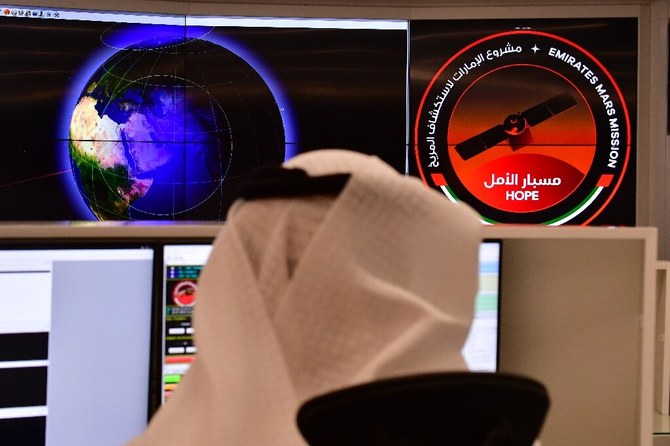
- ARAB NEWS
- 13 Jul 2025

Rebecca Anne Proctor
DUBAI: On July 20, the UAE’s Hope spacecraft began its journey to Mars, taking off at 1:58 a.m. from the Tanegashima Space Center in Japan. It has since travelled over 2.47 million kilometers into a 493 million kilometer, seven month journey, after which it is scheduled to reach Mars in February 2021, marking the 50th anniversary of the UAE. The probe was scheduled to launch on July 15, but was delayed due to unstable weather conditions. The date of July 20 marked the third launch date for the probe.
Inside the mission’s command center at the Mohammed bin Rashid Space Centre in the Al Khawaneej area of Dubai, a team of 15 take turns tracking the movement of the spacecraft.
“Nothing about Mars is easy and when it comes to sending a probe to Mars, 50 percent of the missions have already failed,” Omran Sharaf, director of the Emirates Mars Mission’s (EMM) Hope probe told Arab News. “It’s the first time that the UAE has sent a deep space mission, and on top of that a mission to Mars.”
The team has gone against the odds by launching the mission during the coronavirus disease (COVID-19) pandemic. “COVID-19 put the mission at risk,” explained Sharaf. “We were at risk of actually having to delay the mission by two years because the opportunity to launch a probe to Mars comes once every two years.”
During the timeframe available, which included sending the team to the launch site in Japan, airports shut down all over the world, and travel restrictions were imposed. “It was at the peak of the spread of the virus. But because the team was able to identify the risks early on before the country decided imposing travel restrictions, we put plans in place for operating under the worst case scenario,” said Sharaf.
In turn, they had to shift the spacecraft to Japan two weeks earlier than planned. A team was also sent prior to the scheduled date so that they could enter quarantine in Japan and then receive the spacecraft when it arrived. The team, which was supposed to travel back and forth between the UAE and Japan, had to spend four months in Japan that stretched into the holidays of Ramadan and Eid.
“Nothing is impossible,” said Sharaf. “This is the Arab world’s first mission to Mars. The name itself, that the UAE’s prime minister gave to the probe, Hope, is a message to the Arab youth. The message is that if the UAE is able to reach Mars fewer than 50 years after becoming a nation, then we can do much more.
“The Middle East region has more than 100 million young people in it,” continued Sharaf. “This is a region that has a history of generating knowledge. Scientists from this region over 1,000 years ago generated knowledge and contributed to humanity, who came from different backgrounds. They lived in the region, built the region and contributed to humanity by bringing that new knowledge. The moment we stopped generating such knowledge, stopped accepting difference and coexistence, as a region we started moving backwards.
The UAE Mars mission is just one of many of the country’s ground-breaking plans for innovation. Its aim is to provide the first complete picture of the Martian atmosphere. This includes an understanding of the climate dynamics and the global weather map through characterizing the lower atmosphere of Mars as well as an explanation of how the weather changes the escape of hydrogen and oxygen through correlating the lower atmosphere conditions with the upper atmosphere.
The communication between the probe and Earth is made possible via US space agency Nasa’s Deep Space Network, through antennae at Goldstone in California, Canberra, Australia, and Madrid, Spain.
“So far the journey of the probe is going well and is in good condition,” explained Sharaf. “We are still in the commissioning phase where we are checking the status of various subsystems and the system overall and try and understand various aspects of it while it is in space.”
Within 13 days, the mission will move on to a more complicated phase, when it shifts into the cruising phase, whereby contact with the spacecraft will take place twice a week in slots of six to seven hours. As the probe moves farther away from Earth, the team expects a delay in receiving the telemetry.
The probe will remain orbiting Mars for an entire Martian year — 687 days — in order to gather sufficient data. A single orbit around Mars will take the probe 55 hours.
“When we reach Mars next year we will slow down the probe in order to capture the orbit of Mars,” said Zakareyya Al-Shamsi, deputy manager of mission operations in the EMM. “We then will transfer the information to the scientists who will analyze the data found.”
The goal of EMM is revolutionary for our understanding of the Martian climate. It aims to provide scientists with a thorough insight into the past and future of Earth as well as the potential for life on Mars for humans, and on other distant planets.